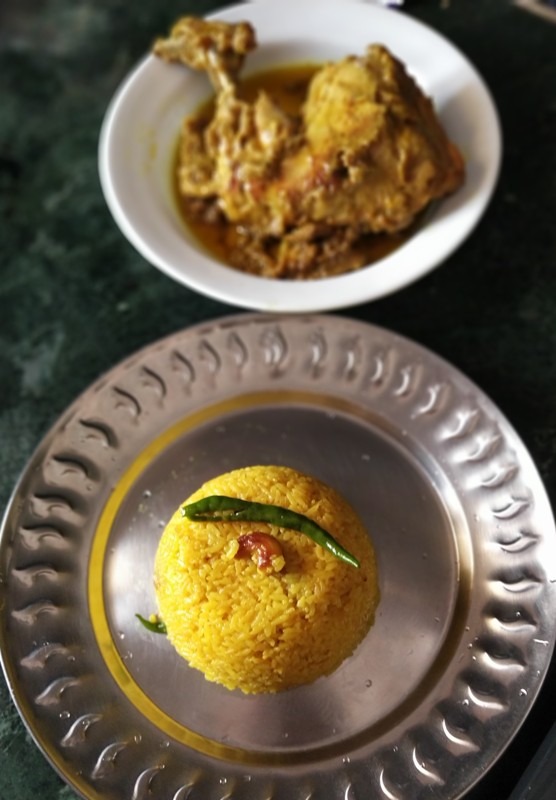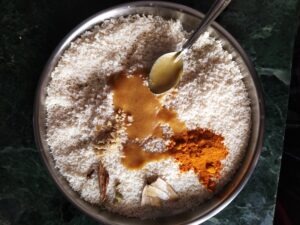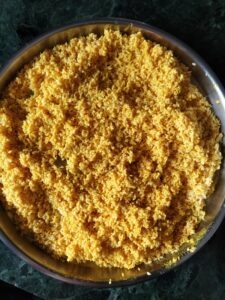About The Author
Hello! From Chuchura (in Hooghly District) and a foodie, I created this blog with a mission to preserve the food of the land; with a message to encourage and promote clean and real food. I hope you enjoy and gain out of this blog, happy reading!
Looking forward to read and hear your feedback.
Basanti pulao is a Bengali favorite during festivals.
First Impression
As you serve, you notice the pleasant and warm yellow color of the pulao.
Very soon a divine and sweet fragrance engulfs you – the aroma from the ghee, gobindobhog rice and toasted cashew nuts transports you to a another world.
As you take the first bite, you relish the subtle yet aromatic flavors of the rice, the ghee and the toasted nuts and raisins.
The pulao is sweet and the spicy side dishes balance the flavors, making for a complete meal.
History, Origin & Finer Details of the Basanti Pulao
Basanti Pulao is not a Bengali invention like many other dishes that came to India through the conquerors and got improvised and modified to suit the palette of the local population.
The History of Basanti Pulao
A very famous pulao from the kitchen of Mughals was the Shahjani Zard Pulao. This pulao used generous amounts of saffron.
When the Mughals came to Bengal, the Nawabs at Dhaka (which was capital of Bengal initially) and Murshidabad (the capital of Bengal after Dhaka) took a flair for cooking the pulao using the same technique. With time this pulao became an aspirational dish for the the general population in the region.
Saffron was however expensive and it still is. Turmeric was used instead to get the yellow color. And that is how Basanti Pulao came into existence.
When is Basanti Pulao Traditionally Prepared?
Basanti Pulao is cooked with much fanfare during the Bengali New Year, also called Poila Boisakh. It is served with kawsha mangsho which is goat meat cooked with spices on a slow flame for a long duration.
Many also prepare this dish during Durga Pujo and Saraswati Pujo.
A Perfect Basanti Pulao
A perfect pulao should –
- Sport a yellow hue without smelling of turmeric
- Have separate grains and not turn into a lump when you serve
- Aroma from ghee should be subtle and should not overpower the senses
- Have a sweet flavor that does not overpower the taste buds
Side Dishes for Basanti Pulao
Basanti Pulao can be served with both veg and non-veg side dishes. Among the veg, it goes best with Aloo’r Dum (Bengali Dum Aloo). In non-veg, it is traditionally served with a spicy slow cooked Bengali mutton curry, called as kosha (pronounced ‘kawsha’) mangsho.
The above are best options. You can also consider a cauliflower curry and chicken kosha.

Very recently, I had cooked this pulao with chicken kosha cooked in Golbari style and was surprised with the excellent amalgamation of flavours.

Note
The equipment & ingredient quantity provided in this recipe is to assist you in cooking this dish. Feel free to experiment with your ingredients. Remember that we all have different set, size & shape of kitchen tools in our pantry.
Equipment
- Knife
- Wok
- Spatula
- Preparation and serving bowls/spoons
Ingredients
- 400 g Gobindobhog rice
- 2 tbsp ghee
- 16-20 pc whole cashews halved
- 8-12 pc raisins (kismis)
- 4 pc green chilies slit in half
- 2 tsp salt
- 2 tbsp sugar
- 600 ml hot water 1.5 times the amount of rice
For Marinading the Rice
- 2 tbsp ghee
- 2 inch ginger
- 2 pc bayleaf
- 2 inch stick of cinnamon (dalchini)
- 6 pc whole cardamom (elaichi)
- 4 pc cloves (lavang)
- 1 tbsp turmeric powder
Instructions
- Wash the gobindobhog rice for a couple of times to remove the dust and starch
- Soak the cashew nuts and raisins in water for an hour
- Allow the rice to dry – this can take around one hour
- Finely chop the ginger
- Once the rice is dry or at least 80-90% dry, marinade it with all the ingredients mentioned under "For the Rice Marinade" – ghee, ginger, turmeric, cloves, cinnamon, cardamom, bayleaf

- Allow this to rest for 1 hour

- Take a wok and add ghee
- On a medium flame, fry the cashew nuts and raisins separately
Cooking the Basanti Pulao
- In the same wok, add ghee
- Once hot, add the marinaded rice prepared in the previous steps
- On a medium flame, continuously stir the rice till the rice grains appear glassy and emits a beautiful aroma from the rice, ghee and spices
- Once you have stirred the rice for around 5 minutes, add the cashew nuts and raisins and stir for another minute
- Add hot water and cover.
- Allow this to cook for the next 15 minutes on a medium flame. You can check in between and if required add hot water
- Once the rice is 80% cooked, add the slit green chilies, salt and sugar and mix properly. There should be minimum or very less water in the wok
- Cover and allow to cook for another 2-4 minutes
- Put off the flame and allow to rest for the next 5-10 minutes
Notes
- Frying the rice is important to prevent the pulao from smelling of turmeric powder
- The amount of water to cook the pualo is an important aspect of Basanti Pulao. More water would mean a mushy pulao and less would mean a mess. To avoid this, follow the below guidelines
- Use the same measuring cup for the rice and water
- For one cup of rice, use 1.5 cups of hot water
- Using hot water is important, else your rice might turn into a lump while it cooks
- Ensure that the rice is dry after you have washed it and before marinading it with turmeric, ghee and ginger
- Do not miss out on gobindobhog rice for the optimum flavors. If gobindobhog rice isn’t available locally, use any other aromatic varieties except the basmati rice. This can include the jeera samba rice from Tamil Nadu as well.


Pingback: How to Cook A Perfect Mutton Kosha Every Single Time
Pingback: 6 Gobindobhog Rice Recipes You Will Fall In Love With
Pingback: Is The Lady With A Ladle Worth A Try?
Pingback: Chicken Yakhni Pulao Using Bengali Gobindobhog Rice - FinallyFoodie.com
Pingback: Chicken Kosha Recipe | Bengali-Style Kosha Mangsho Using Chicken